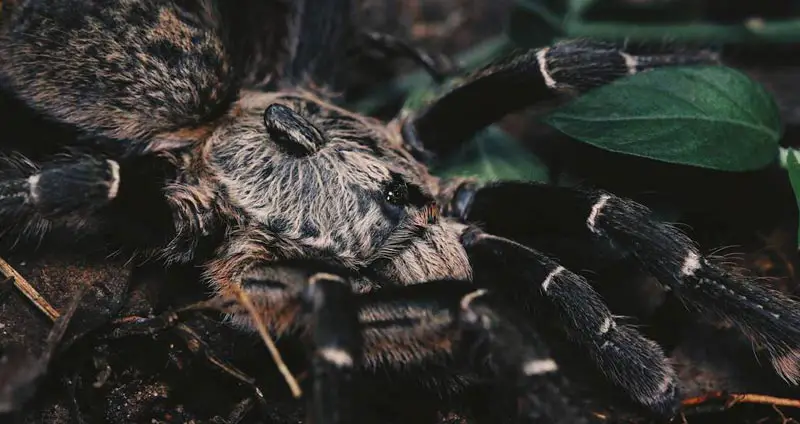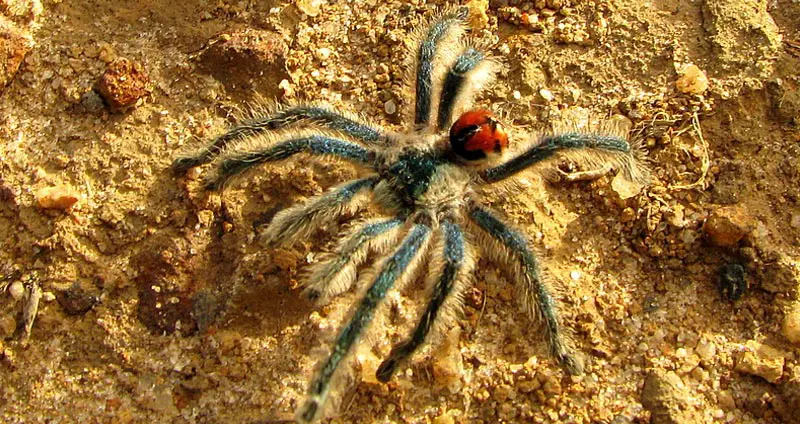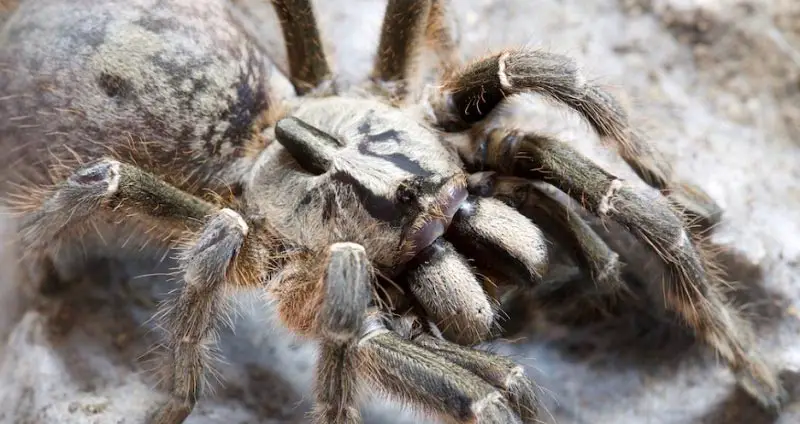Ceratogyrus darlingi, better known as the Rear-Horned Baboon tarantula, is native to the southern region of Africa. It enjoys a special place among the over 800 species of tarantula with its multi-colored carapace and a visually striking horn putting it high on the list of many tarantula enthusiasts.
Table of Contents
Ceratogyrus darlingi Care Sheet
| | |
Common Name |
Rear-Horned Baboon |
Species Type |
Old world terrestrial |
Natural Habitat |
Found in parts of Africa and Mozambique. Its climate tends to be consistently hot and humid, but not swampy. |
Growth Rate |
Fast growth rate, growing several inches per year. |
Adult Size |
Females reach a legspan of about 5″, with males measuring slightly smaller. |
Lifespan |
Females live for about 15 years while males live for about 4. |
Enclosure |
The enclosure should be wider than it is tall, with at least six inches of substrate for burrowing. Both a hide and a water dish should be available. The enclosure should have good airflow. |
Temp/Humidity |
78°F to 82°F with about 75% humidity. |
Diet |
This tarantula is a great eater. It can eat several adult-sized crickets or two dubia roaches per week. |
Temperament |
A more aggressive tarantula that has a short temper and a very painful bite to back up any threat poses. |
Experience Level |
Intermediate – Not difficult to care for enclosure-wise, but it’s a relatively dangerous tarantula to be around. |
Average Cost |
Slings ~ $20, Males ~ $75, Females ~ $90+ |
Ceratogyrus darlingi Appearance
If you’re a big spider fan and need something unique for your tarantula collection, then the visual fidelity of the Ceratogyrus darlingi will make for an excellent addition. This species grows to a decent size of around 4.5 inches to 5 inches.
The color of their body ranges from black, grey, and mud-brown. Of course, the most noticeable feature of the tarantula is the black horn protruding from the carapace’s center.
Upon closer inspection, the horn has a slight curvature to it, unlike the straight horn of Ceratogyrus marshalli. It is common among the Ceratogyrus genus of tarantulas to sport a foveal horn on the peltidium.
Female spiderlings will take around 2 to 4 years to reach full-size and can live up to 15 years. Males mature a lot quicker and will take anywhere from 1.5 to 3 years to reach full size, but unfortunately only live for 4 years.

via @db_born_wild / Instagram
Ceratogyrus darlingi Temperament
C. darlingi is an old world tarantula, which explains its aggressive and formidable traits. They will not live in communal with any other species and will attack them. The Rear-Horned Baboon tarantula is very fast on its feet, which means you should handle them with care (or don’t handle them at all).
These tarantulas do not come with urticating hairs. Instead, they let their venom do the talking. They will not shy away from using their venom on human handlers or any potential threat. Their bite and venom feels like a minor bee sting but can wreak havoc on your immune system.
Upon getting bitten, it is common to feel headache, nausea, and even muscle spasms. For these reasons, we do not recommend these species because some experience is required to handle them.
Despite its rough personality, it’s an entertaining experience to own one of these tarantulas. It attacks prey with a vengeance and typically has very good energy. All in all, it’s a great display tarantula species.
Housing Ceratogyrus darlingi
It is easy to arrange an enclosure for this species since they don’t grow bigger than 5” in leg span and don’t have many specific care requirements.
Just make sure to follow the optimal temperature and humidity conditions for their enclosure.
Optimal Ceratogyrus darlingi Enclosure
This is an average-sized terrestrial tarantula, so it requires an enclosure that caters to these needs. It should be kept in a terrarium that has more of an emphasis on floor space over height. This enclosure should also have great cross-ventilation, in addition to great security and overall build quality.
An adult specimen will thrive in an enclosure like the Exo Terra 18″ x 18″ x 12″ terrarium. This enclosure is plenty large enough with great cross-ventilation, accessibility, and visibility. It’s also well-built and will keep your tarantula safe and secure without worries.
Enclosure Decorations
Ceratogyrus darlingi needs a few supplies to make their cage a little more habitable. Being an obligate burrower, these spiders don’t require any special arrangements such as a tarantula hide (although it’s still recommended), but they do require about 6 inches of substrate.
Use a nice combination of vermiculite, coconut fiber, peat moss, and dirt as the substrate and your tarantula will feel right at home! For the most part, try keeping the substrate dry; periodically adding water to half the substrate before allowing it to dry out.
Although the Rear-Horned Baboon tarantula may not directly drink from it, make sure to add a water dish to prevent dehydration and keep the enclosure humid.
If you are feeling creative, you could try adding a few plants in their cage as decorations. It is recommended to place fake plants in there since they require zero effort in the way of maintenance. By contrast, live plants require a light source to maintain the flora. Since the tarantulas are nocturnal hunters, they abhor light sources.
Enclosure Humidity/Heating
Ceratogyrus darlingi prefer to live in a climate that’s similar to their natural environment of Africa and Mozambique. They cannot survive in a highly humid environment. Make sure the enclosure has plenty of ventilation to keep optimum levels of humidity.
The best environment for these tarantulas is dry and arid, which means that regular room conditions may not be ideal for them. Make sure to spray the cage every few weeks to raise the humidity levels for a short duration. Be careful not to directly target the tarantula with this spray.
The ideal humidity conditions for these tarantulas are at 70%. Keep the temperature in the 78°F to 82°F range to mimic their natural habitat. It is recommended to maintain a temperature gradient inside the enclosure, with one end being cool and the other being slightly warmer.
Keep track of the temperature and humidity with the help of a simple hygrometer and thermometer.
Diet
The Rear-Horned Baboon tarantula has a very rapid growth rate. Spiderlings are known to reach 3 inches in size within the first year. This means they require a very consistent feeding cycle with temperatures hovering around the low 80s.
Being voracious eaters, there’s no such thing as overeating for these tarantulas. They will gladly gobble up bite-sized insects such as earthworms, roaches, cricket, and sling worms.
Despite their aggressive temperament, they usually do not go for larger prey. Make sure to remove any uneaten food from the cage if Ceratogyrus darlingi refuses to eat them.
Health Concerns
Captive-held tarantula don’t experience many health issues as long as they’re properly fed and their enclosures are optimal. The most common problems that pet tarantulas experience are dehydration and mites, but these are easy to avoid and deal with.
It’s important to note that you should supply your Ceratogyrus darlingi with plenty of substrate to burrow into. If this isn’t provided, or if the enclosure is too small, it may result in some behavioral or health problems.
Ceratogyrus darlingi For Sale & Price
Despite their nasty attitude and venomous bite, these aggressive tarantulas are easy to acquire in the market. They are not very expensive either and most vendors will sell them at a cost of around $35 to $90 depending on the sex and age of the specimen.
For such a low price, this tarantula is well worth the investment! It has a very unique appearance and a temperament that makes it fun to own. It isn’t very beginner-friendly, but it can bring lots of joy to experienced keepers.

